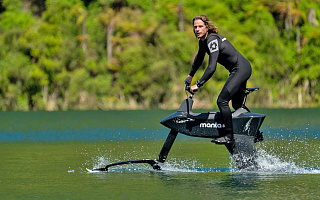
So you are a jetsurfer now - tips and hints for beginners
Welcome to the fast and wet world jetboarding - today we are going to revise a few musts and shouldnts that would be suitable for any rider, no matter how experienced they are. To have more fun, remember to stay more safe.
We are going to break the manual into three segments: the initial setup, the surfing process itself, and the post-ride routines.
Here goes:
INITIAL SETUP
-
Do some research
Jetboarding is extreme enough on its own, so it’s a good idea to gather some due diligence prior to your ride - check for reports on sharks attacks, jellyfish migrations and other events that might take place in your area.
-
Check your gear
Safety always should come first, so always be sure to check your board before even heading out to the water. All the compartments should be sealed, all the connections should operate properly.
-
Respect your ride
Jetboards are tough, but there is no need to check it when it’s not necessary. Don’t leave your board in the open sun, avoid dropping it intentionally, etc. Common sense.
-
Protection
The word “jet” should give you quite a hint that this is quite a risky experience. Use protective helmets, vests and bodysuits to minimise the unwanted dangers. Come on.
GETTING YOUR FEET WET
-
Find a proper spot
This becomes crucial if you have little esurfing experience. Remember, that this is a fully motorized vehicle that can achieve serious speed - and some you can get to different objects really fast. So it is your responsibility at all times to ride safely and stay away from swimmers, animals, debris, piers, buoys, reefs and so on - at all times.
-
Stay away from that foil or propeller
No matter which board you use, make sure you always stay away from the foil or propeller - don’t use it to get on the board, never get your body parts close to it.
-
Control the throttle
Start slowly, maintaining constant speed. When you feel comfortable and confident, try transitioning from your belly to standing on your knees. That’s the optimal position to catch initial balance and practice some slight turning. When you are okay with that - proceed to standing on your feet. Maintain speed to maintain balance and slightly shift forward as speed increases.
-
The Death Grip
Under the grim name resides a very simple technique that can drastically improve your riding. To maximise your grip strength - release your pinky when you grab the throttle. It also makes you look fancy.
-
Rest
The board is equipped with a motor, not you. Take an occasional rest, grabbing your board. Don’t forget to turn the engine off, though.
-
Learn to bail
Many skateboarders and surfers know that falling is even more important than riding. Practice your bailing - in the last moment of balance learn to get off the board to the sides or back of your ride.
-
Watch the power
It’s easy to get carried away by all the adrenaline pumping, so don’t forget to watch the remaining juice you have left. And never open the compartments while in water - take the board to the shore.
AFTER THE RIDE
-
Maintenance
Don’t delay the service routines after you get out of the water - dry your board a bit, make sure there is no sand or salt remaining and follow the service manual prolong the life of your trusty steed.
That’s pretty much it - take your time, prepare properly and enjoy your ride like we do.
Later we will discuss more in depth tips and hints for specific board types and models, but those advices should work for anyone.
See you in the water.






